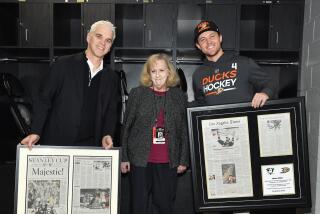A Fleeting Glance
- Share via
Stiff as starch, as traditional as a tea cart and as formal as evening attire . . . yes, that’s the image the British Open likes the best.
It’s almost as though history doesn’t count unless it happened on one of those links courses, where the only thing separating a golf ball in flight from a large body of water is a spit of land with so many humps and bumps it seems that farm animals or small cars must be buried in there.
Anyway, against this backdrop, Nick Faldo had a chance to make British Open history when he stood on the 15th tee at Muirfield on the last day of the 1992 Open Championship. No one since James Braid in 1906 had won two Open titles at Muirfield, and Faldo had a shot at a victory that would match the one he earned in 1987 on the same course.
It wasn’t going to be easy, as the English tabloids liked to remind Faldo. A four-shot lead was gone as he reached No. 15, but Faldo birdied two of the last four holes to overtake John Cook and win the Claret Jug for a third time.
As far as great moments in British Open history go, it wasn’t bad. The time came for Faldo to make his acceptance speech. Listening intently were thousands of fans, a television audience of millions and a bunch of men with jackets and ties and backs so straight you could use them as flagsticks.
“From the bottom of my heart,” Faldo said, then hesitated and began again. “From the heart of my bottom, I want to thank the British press.”
As far as great moments in British Open tabloid history go, it wasn’t bad. In fact, it was downright spectacular.
All right, so Faldo became the first in 86 years to win two Open titles at Muirfield. Mere piffle.
More important, Faldo became the first British Open champion to use his victory speech as a platform to rail against the tabloids, automatically jerking them out of the gutter and flinging them headlong into a bold new era.
It’s as if the tabloids finally could say, “We may be small in stature, but we’re really big when it comes to wreaking havoc!”
What had the tabloids done to Faldo? The usual stuff. Criticized him, poked into his personal life, accented his failings, printed unflattering pictures.
Mostly they did it the normal way, through bold, provocative, sometimes misleading but almost always entertaining headlines, backed up in stories that sometimes even related to the headlines.
Now, you can guess how Faldo was treated in headlines when he failed: “Foldo.” Of course.
Tabloid reporters insist they never wrote the word Foldo, so its use was left up to the headline writers, some of the same journalists who for the Mike Tyson fiasco would come up with such offerings as “Pay for Chew” and “World Chomp.”
This is not exactly a news bulletin, but the English tabloid press has an insatiable appetite for mischief anywhere. Politicians and sex scandals are the staple of the tabloids, but sports figures are regularly pilloried.
Faldo found himself a tabloid favorite early in his career when he was judged to be aloof and unfriendly, not at all like that sandy-haired Scot named Sandy Lyle who was known to share a pint or two with the ink-stained wretches and thus regarded as a much more regular guy.
If tabloid coverage is sometimes unfair, it’s also often true. When Faldo’s marriage was on the rocks, news that he had discovered a new friend, a golfer from the women’s team at Arizona, was found first in a London tabloid. As usual, the problem was the tabloids took it too far. They sent reporters to the woman’s home. They sent photographers to her college classrooms. They chased her in rented cars. They wreaked havoc.
Of course, they also got the story, a fact that cannot be underplayed in the highly competitive tabloid field. Consider that the Sun, famous for its titillating stories and semi-nude pictures of women on Page 3, enjoys a circulation of about 4 million.
When Faldo’s soon-to-be ex-wife showed up at the 1995 Ryder Cup and posed for pictures with her husband, few were fooled, not after the tabloids ran pictures of Faldo and his new friend, Brenna Cepelak.
Actually, Faldo’s situation runs slightly contrary to the tabloid norm, at least for golf, which tends to receive the kinder, gentler treatment. The normal tabloid golf story is something like Tony Jacklin saying semi-provocative things about the U.S. chances in the Ryder Cup, comments by American players about the British Open that are either blown out of proportion or misrepresented entirely or diet suggestions for John Daly.
This is close to what Craig Stadler received in the 1983 Open when he held an early lead at Royal Birkdale. A pretty neat moment for a player, right? One tabloid was unimpressed. It ran a story on Stadler with this headline: “Super Slob.”
By and large, pro golfers at the British Open are treated a lot better than pro tennis players at Wimbledon. This happens for two reasons. One, Wimbledon is across the Thames from London, so it has proximity going for it. Two, Wimbledon has female players.
Wimbledon tabloid coverage this year was dominated by court-level rear-view photos of 16-year-olds Martina Hingis and Anna Kournikova in short dresses, unflattering pictures of an apparently out-of-shape Monica Seles and discussions about her midriff.
Seles should have been accustomed to it. She has been the object of intense coverage by the tabloids at Wimbledon since she skipped it entirely in 1991. The tabloids printed a rumor that she was pregnant. When Seles showed up at Wimbledon in 1992, she was greeted by such questions as whether she thought her bottom was too big and if she was addicted to butter. The butter question came up because Seles once let it slip that she sometimes buttered her bread. She probably won’t make that mistake again.
Once upon a time, the tabloids were located on Fleet Street, but they since have fled to suburban locations. Fleet Street became famous as the home of London journalism, but mostly for the tabloids and their particular bent. There are stories of how many reporters would hole up in their favorite pubs and cover events such as the Crimean War or something from the safety and comfort of their booths.
Those were the days, to be sure. All in good fun, you know. Nothing to take too seriously, eh?
But we’ve got a different set of circumstances now. The tabloids may have left Fleet Street, the tennis players may have left Wimbledon for another year and Faldo may live in Florida now, but the British Open is once again being played on the coast of Scotland.
That’s not too far to go for a tabloid sports story is it? Absolutely not. There’s one thing about the tabloids you can be sure of: They nearly always go too far.
More to Read
Go beyond the scoreboard
Get the latest on L.A.'s teams in the daily Sports Report newsletter.
You may occasionally receive promotional content from the Los Angeles Times.










